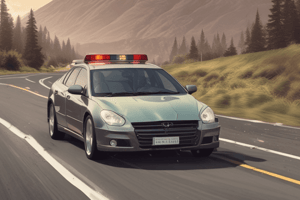Podcast
Questions and Answers
What should a driver do if they find it difficult to focus while driving?
What should a driver do if they find it difficult to focus while driving?
- Push through the discomfort and continue driving.
- Close their eyes for a moment to gather their thoughts.
- Pull over to a safe space until they can regain their focus. (correct)
- Increase the volume of the music to distract themselves.
What age group is statistically most likely to be involved in accidents due to drowsy driving?
What age group is statistically most likely to be involved in accidents due to drowsy driving?
- 46 years and older
- 26-35 years
- 36-45 years
- 16-25 years (correct)
How often should mirrors be scanned in city driving?
How often should mirrors be scanned in city driving?
- Every 15 seconds
- Every 3 seconds
- Every 6 seconds (correct)
- Every 10 seconds
What is the recommended distance to maintain from other vehicles in city driving?
What is the recommended distance to maintain from other vehicles in city driving?
What should a driver do if they miss their turn or exit?
What should a driver do if they miss their turn or exit?
What is the advised approach to handling distractions while driving?
What is the advised approach to handling distractions while driving?
Which of the following statements about speeding is true?
Which of the following statements about speeding is true?
What general advice is given regarding road rage?
What general advice is given regarding road rage?
What action will immediately disqualify a candidate during the driving test?
What action will immediately disqualify a candidate during the driving test?
Which of the following is NOT a requirement for the vehicle used in the driving test?
Which of the following is NOT a requirement for the vehicle used in the driving test?
What is the maximum allowable size for a parking space demonstration during the driving test?
What is the maximum allowable size for a parking space demonstration during the driving test?
When might driving tests be canceled due to weather conditions?
When might driving tests be canceled due to weather conditions?
What maneuver involves turning a vehicle in a small space without making a U-turn?
What maneuver involves turning a vehicle in a small space without making a U-turn?
What should a driver do to prevent their vehicle from rolling when parked uphill with a curb?
What should a driver do to prevent their vehicle from rolling when parked uphill with a curb?
What is required of a driver during the Quick Stop maneuver?
What is required of a driver during the Quick Stop maneuver?
What is the purpose of looking through the rear window during parking maneuvers?
What is the purpose of looking through the rear window during parking maneuvers?
What happens if a candidate refuses to perform a maneuver during the driving test?
What happens if a candidate refuses to perform a maneuver during the driving test?
How many feet should a driver park their vehicle from a sign indicating a stop?
How many feet should a driver park their vehicle from a sign indicating a stop?
Flashcards are hidden until you start studying
Study Notes
Defensive Driving Tips
- Focus is Critical: Stay mentally engaged when driving. If distracted, safely pull over to regain focus.
- Avoid Drowsy Driving: Fatigue significantly increases accident risk, particularly for drivers aged 16-25. Always rest before driving.
- Monitor Other Drivers: Be observant of surrounding drivers and their behaviors. Adjust driving in response to unusual actions.
- Safety Measures: Always wear a seatbelt, maintain a safe distance from other vehicles, and adhere to traffic regulations.
- Regular Scanning: Keep vigilant by scanning mirrors and surroundings every 6 seconds in cities and every 12 seconds on highways.
- Personal Responsibility: Expect potential hazards from other drivers and be prepared to react accordingly.
- Maintain Safe Following Distances: Use the 3-4 second rule in city traffic and the 10-12 second rule on highways to keep a safe distance.
- Control Speed: Adjust speed according to road conditions, traffic, and weather. Always drive within legal limits.
- Plan Your Route: Anticipate turns and lane changes to avoid losing composure if you miss an exit or turn.
- Avoid Road Rage: Keep calm and do not engage in aggressive behavior on the road.
- Minimize Distractions: Focus exclusively on driving. Do not use your cellphone while behind the wheel.
Driving Test Information
- Test Expectations: Remain calm and demonstrate appropriate driving skills. No quotas or unfair practices are involved.
- Disqualification Risks: Violations or hazardous actions can lead to immediate test disqualification.
- Vehicle Requirements: Ensure the vehicle has a valid license plate, registration, proof of insurance, and passes a safety inspection.
- Required Maneuvers: Be prepared to demonstrate various functions, including:
- Straight-in Parking: Center vehicle in an 18' x 9' space without extending into traffic.
- Turnabout: Execute a turn in a 30' to 40' area without performing a U-turn.
- Quick Stop: Stop quickly and safely without tire skidding.
- Parking on a Hill (Simulated): Demonstrate how to secure a vehicle on an incline, including the turning of wheels and using the emergency brake.
Understanding these defensive driving principles and test procedures can enhance safety on the road and increase the likelihood of passing the driving examination.
Studying That Suits You
Use AI to generate personalized quizzes and flashcards to suit your learning preferences.




